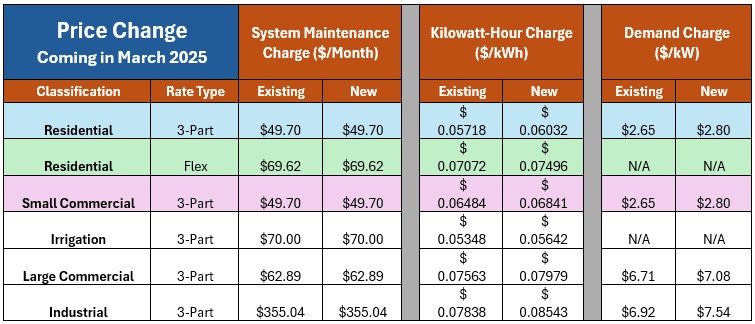LEC Rates
March 2025
Your Lincoln Electric board of trustees voted for a rate change that began on March 1, 2025. The adjustment considered both the latest and next estimated Bonneville Power Administration (BPA) wholesale power cost increase. Since wholesale power makes up about half our overall expenses, anytime there is a BPA increase, we must adjust our members’ rates accordingly.

COSA Based Rates
From 2017 to 2021, Lincoln Electric gradually adjusted our rates to better reflect the recommended rate structure based on a Cost of Service Analysis (COSA). The COSA analyzes all Lincoln Electric expenses and revenues to determine how costs should be most fairly distributed among different rate classes. The COSA uses a three-part rate structure of system maintenance, usage, and demand charges to match how Lincoln Electric is billed for wholesale power.
System maintenance charge
Our system maintenance charge for residential, commercial, and industrial rate classes are currently set to match the COSA recommendation to cover our fixed costs. Fixed costs, such as taxes, depreciation, and maintenance, are expenses Lincoln Electric has regardless of how much electricity our members use. The system maintenance charge helps establish more equitable rates so all members help to cover these expenses, whether they use 1 or 10,000 kWh.
Usage Charge
The usage charge is calculated by taking a service’s kilowatt-hour use for the month and multiplying it by the kilowatt-hour charge for the appropriate rate class. This is the portion of your bill that is most easily controlled through your household habits. If you practice good energy efficiency, you can help reduce the amount of electricity you use. However, it’s important to note that it can still be greatly impacted by weather, especially if you use electricity for any type of heating or cooling.
demand charge
Demand is measured in kilowatts (kW) and each member’s billing demand is set based on their highest average demand over a 15-minute period during the month. Your demand is multiplied by the kilowatt-hour charge for the appropriate rate class. Demand is what you are asking the electric grid to supply to your service at a single point in time. Many members set their max demand for the month when multiple electric appliances are operating at the same time.
example
NEED TO THINK ABOUT YOUR BILL IN A DIFFERENT WAY?
For some people, it’s easier to understand electric bill parts when you compare them to a vehicle, where usage (kWh) is the odometer and demand (kW) is the speedometer. Your usage (kWh) is the total number of miles driven over a period of time. But your demand (kW) is the speed at which you are going. It is what you are asking of your vehicle (or the grid) at a single point in time. As you can see, speed (demand) is not directly correlated with mileage (usage), but to the behavior of the drivers. The same is true of electricity use, though demand is typically more impacted by the electric makeup of the home rather than the occupants.

Driver 1
Commutes from Eureka to Kalispell
Reaches a maximum speed of 50 mph
MONTHLY NUMBERS
Mileage: 2,400 miles
(total usage or kWh)
Maximum Speed: 50 mph
(demand or kW)

Driver 2
Commutes from Mud Creek to Eureka
Reaches a maximum speed of 90 mph
MONTHLY NUMBERS
Mileage: 200 miles
(total usage or kWh)
Maximum Speed: 90 mph
(demand or kW)